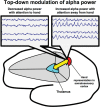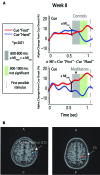Mindfulness starts with the body: somatosensory attention and top-down modulation of cortical alpha rhythms in mindfulness meditation - PubMed (original) (raw)
Mindfulness starts with the body: somatosensory attention and top-down modulation of cortical alpha rhythms in mindfulness meditation
Catherine E Kerr et al. Front Hum Neurosci. 2013.
Abstract
Using a common set of mindfulness exercises, mindfulness based stress reduction (MBSR) and mindfulness based cognitive therapy (MBCT) have been shown to reduce distress in chronic pain and decrease risk of depression relapse. These standardized mindfulness (ST-Mindfulness) practices predominantly require attending to breath and body sensations. Here, we offer a novel view of ST-Mindfulness's somatic focus as a form of training for optimizing attentional modulation of 7-14 Hz alpha rhythms that play a key role in filtering inputs to primary sensory neocortex and organizing the flow of sensory information in the brain. In support of the framework, we describe our previous finding that ST-Mindfulness enhanced attentional regulation of alpha in primary somatosensory cortex (SI). The framework allows us to make several predictions. In chronic pain, we predict somatic attention in ST-Mindfulness "de-biases" alpha in SI, freeing up pain-focused attentional resources. In depression relapse, we predict ST-Mindfulness's somatic attention competes with internally focused rumination, as internally focused cognitive processes (including working memory) rely on alpha filtering of sensory input. Our computational model predicts ST-Mindfulness enhances top-down modulation of alpha by facilitating precise alterations in timing and efficacy of SI thalamocortical inputs. We conclude by considering how the framework aligns with Buddhist teachings that mindfulness starts with "mindfulness of the body." Translating this theory into neurophysiology, we hypothesize that with its somatic focus, mindfulness' top-down alpha rhythm modulation in SI enhances gain control which, in turn, sensitizes practitioners to better detect and regulate when the mind wanders from its somatic focus. This enhanced regulation of somatic mind-wandering may be an important early stage of mindfulness training that leads to enhanced cognitive regulation and metacognition.
Keywords: alpha rhythm; attention; chronic pain; depression relapse; mindfulness meditation; somatosensory cortex; thalamocortical loop.
Figures
Figure 1
Summary of predictions on the effects of Standardized Mindfulness Training (ST-Mindfulness) on cognitive and clinical conditions through top–down alpha modulation. Green arrows—enhanced functions A → B: ST-Mindfulness enhances working memory (WM) (e.g., Jha et al., ; Van Vugt and Jha, 2011) and cued selective attention (e.g., Jha et al., ; for a related task, see also Jensen et al., 2012a,b). α → B: Top–down alpha modulation is associated with enhanced WM performance (e.g., Tuladhar et al., ; Jensen and Mazaheri, ; Van Dijk et al., 2010) and enhanced sensory perception in selective attention tasks (Kelly et al., ; Jones et al., ; Foxe and Snyder, 2011) with TMS studies suggesting alpha is causally implicated in memory (Sauseng et al., 2009) and perceptual tasks (Romei et al., 2010) A → α: ST-Mindfulness enhances attentional modulation of alpha rhythms in SI (Kerr et al., 2011a,b). Red arrows—reduced functions A → C: ST-Mindfulness reduces distress in chronic pain (e.g., Sephton et al., ; Gaylord et al., ; Schmidt et al., 2011) and reduces risk of depression relapse (e.g., Teasdale et al., ,; Segal et al., 2010). C → B: WM and selective attention performance are reduced in chronic pain (e.g., Gijsen et al., ; Moore et al., 2012) and depression (e.g., Goeleven et al., ; Roiser et al., 2012). Blue arrows—hypothesized mechanisms of ST-Mindfulness. Primary: A → α → C: We predict that 8-week ST-Mindfulness training elicits enhanced top–down alpha modulation in sensory cortex that corresponds to improved clinical conditions including chronic pain and depression. Secondary: A → α → B → C: We further predict that top–down alpa modulation after ST-Mindfulness for clinical conditions will be correlated with performance on cognitive measures including selective attention and working memory.
Figure 2
Thalamocortical circuitry involved in ST-Mindfulness and somatosensory attentional modulation of alpha rhythms. Attentionally driven increases in alpha rhythm power broadly suppress sensory throughput in the unattended area (via thalamocortical mechanisms); spatially specific suppression of alpha facilitates sensory throughput in the attended area from the sensory periphery to the thalamus and on to the cortex.
Figure 3
Alpha modulation and ST-Mindfulness training. (A) Compared to non-meditators, ST-Mindfulness subjects' exhibit greater alpha differentiation between attend-hand vs. attend-foot conditions in the early post-cue period [600–800 ms, indicated by shaded region; originally published in Kerr et al. (2011a,b). Permission to use figure received from _Brain Research Bulletin_]. (B) From two participants, illustration of SI localization, with equivalent current dipole (blue dots) overlaid on MRI brain structure images proximal to the omega shape in the anterior bank of the post-central gyrus.
Figure 4
Schematic illustration of computational neural modeling predictions on the origin of alpha. Green arrows represent excitatory synaptic connections and red circles inhibitory synaptic connections. We hypothesize that focal changes in alpha can be achieved by modulation of the lemniscal thalamic Ventral-Posterial medial (VPm_) pathway to SI, while diffuse regulation can be achieved through modulation of non-specific Ventral-Medial (VM) thalamic drive. The VM thalamic nucleus is under direct inhibitory control of the Basal Ganglia/Striatum circuit, which is influenced by the prefrontal cortex. These pathways suggests alpha modulation occurs through alteration of prefrontal-basal ganglia—thalamocortical circuits in ST-Mindfulness practitioners (see discussion in “Part-4: Predictions from our Computational Neural Model on Neural Mechanisms Underlying Enhanced Alpha Modulation in ST-Mindfulness,”).
Similar articles
- Effects of mindfulness meditation training on anticipatory alpha modulation in primary somatosensory cortex.
Kerr CE, Jones SR, Wan Q, Pritchett DL, Wasserman RH, Wexler A, Villanueva JJ, Shaw JR, Lazar SW, Kaptchuk TJ, Littenberg R, Hämäläinen MS, Moore CI. Kerr CE, et al. Brain Res Bull. 2011 May 30;85(3-4):96-103. doi: 10.1016/j.brainresbull.2011.03.026. Epub 2011 Apr 8. Brain Res Bull. 2011. PMID: 21501665 - Cognitive effects of MBSR/MBCT: A systematic review of neuropsychological outcomes.
Lao SA, Kissane D, Meadows G. Lao SA, et al. Conscious Cogn. 2016 Oct;45:109-123. doi: 10.1016/j.concog.2016.08.017. Epub 2016 Aug 28. Conscious Cogn. 2016. PMID: 27580462 Review. - [Mindful neuropsychology: Mindfulness-based cognitive remediation].
Bulzacka E, Lavault S, Pelissolo A, Bagnis Isnard C. Bulzacka E, et al. Encephale. 2018 Feb;44(1):75-82. doi: 10.1016/j.encep.2017.03.006. Epub 2017 May 5. Encephale. 2018. PMID: 28483271 Review. French. - The effectiveness of mindfulness based programs in reducing stress experienced by nurses in adult hospital settings: a systematic review of quantitative evidence protocol.
Botha E, Gwin T, Purpora C. Botha E, et al. JBI Database System Rev Implement Rep. 2015 Oct;13(10):21-9. doi: 10.11124/jbisrir-2015-2380. JBI Database System Rev Implement Rep. 2015. PMID: 26571279
Cited by
- Influence of High-frequency Yoga Breathing (Kapalabhati) on States Changes in Gamma Oscillation.
Budhi RB, Singh D, Goswami J, Manjunath NK, Vinchurkar S. Budhi RB, et al. Int J Yoga. 2024 May-Aug;17(2):106-115. doi: 10.4103/ijoy.ijoy_5_24. Epub 2024 Sep 13. Int J Yoga. 2024. PMID: 39444665 Free PMC article. - Beyond coincidence: An investigation of the interplay between synchronicity awareness and the mindful state.
Rosenstreich E, Russo-Netzer P, Icekson T. Rosenstreich E, et al. PLoS One. 2024 Oct 14;19(10):e0307443. doi: 10.1371/journal.pone.0307443. eCollection 2024. PLoS One. 2024. PMID: 39401263 Free PMC article. - Identifying subgroups of urge suppression in Obsessive-Compulsive Disorder using machine learning.
Eng GK, De Nadai AS, Collins KA, Recchia N, Tobe RH, Bragdon LB, Stern ER. Eng GK, et al. J Psychiatr Res. 2024 Sep;177:129-139. doi: 10.1016/j.jpsychires.2024.06.052. Epub 2024 Jun 29. J Psychiatr Res. 2024. PMID: 39004004 - Assessment of Temporal Somatosensory Discrimination in Females with Fibromyalgia: Reliability and Discriminative Ability of a New Assessment Tool.
Demoulin C, Jodogne L, David C, Kaux JF, Vanderthommen M. Demoulin C, et al. Sensors (Basel). 2024 May 22;24(11):3300. doi: 10.3390/s24113300. Sensors (Basel). 2024. PMID: 38894094 Free PMC article. - The effect of conscious mindfulness-based informative approaches on managing symptoms in hemodialysis patients.
Akbulut G, Erci B. Akbulut G, et al. Front Psychol. 2024 May 9;15:1363769. doi: 10.3389/fpsyg.2024.1363769. eCollection 2024. Front Psychol. 2024. PMID: 38800673 Free PMC article.
References
- Analayo B. (2004) Satipatthana: The Direct Path to Realization Birmingham: Windhorse Publications
- Anderson N. D., Segal Z. V., Lau M. A., Bishop S. R. (2007). Mindfulness-based stress reduction and attentional control. Clin. Psychol. Psychother. 14, 449–463
- Babiloni C., Brancucci A., Babiloni F., Capotosto P., Carducci F., Cincotti F., et al. (2003). Anticipatory cortical responses during the expectancy of a predictable painful stimulation. A high-resolution electroencephalography study. Eur. J. Neurosci. 18, 1692–1700 10.1046/j.1460-9568.2003.02851.x - DOI - PubMed
Grants and funding
- P41 RR014075/RR/NCRR NIH HHS/United States
- K24 AT004095/AT/NCCIH NIH HHS/United States
- R01 NS045130/NS/NINDS NIH HHS/United States
- K01 AT003459/AT/NCCIH NIH HHS/United States
- R21 AT003425/AT/NCCIH NIH HHS/United States
- R01 AT006344/AT/NCCIH NIH HHS/United States
- T32 GM007484/GM/NIGMS NIH HHS/United States
- K25 MH072941/MH/NIMH NIH HHS/United States
LinkOut - more resources
Full Text Sources
Other Literature Sources



